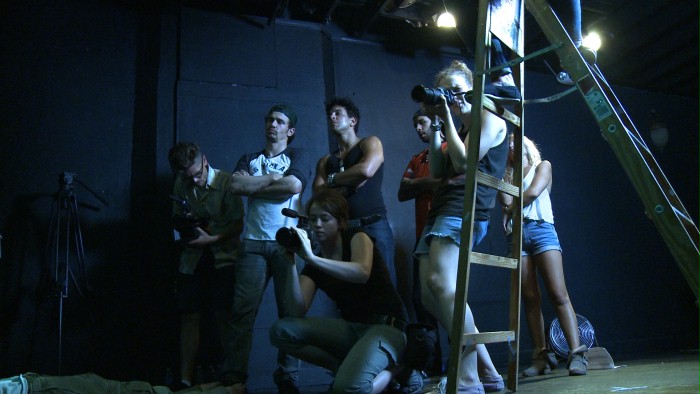INTERIOR. LEATHER BAR
 Tuesday, July 23, 2013 at 2:32PM
Tuesday, July 23, 2013 at 2:32PM Stars: Val Lauren, James Franco, Travis Mathews and Christian Patrick.
Writer: Travis Mathews.
Directors: Travis Mathews and James Franco.
Rating: 2.5/5

Those drawn to this experimental ‘acting group’ piece hoping to see A-lister James Franco partaking in a much-touted recreation of gay S&M action so gratuitous that it had to be excised from William Friedkin’s 1980 thriller, Cruising…well, you’ll be resolutely pissed off.
Co-directors Travis Mathews (who seems to do all the directing) and Franco are instead endeavouring to confront the ingrained prudishness of modern society to the open and graphic portrayal of sexuality in mainstream film narrative. That much is all spelt out for the viewer by Franco in an impassioned rant about two-thirds of the way through this intriguing though wanly sterile oddity.
When Cruising landed in cinemas, audiences weren’t ready for the frankness with which Friedkin tackled the underground homosexual club culture in an time prior to the AIDS epidemic. Starring Al Pacino as a detective who delves into the leather-clad world of the hardcore gay lifestyle, the first full cut left the MPAA rattled; legend has it the Board demanded at least 40 offending minutes had to go just to secure the film an R rating. The fact that no shooting script remains intact and Friedkin's reputation as an joyous embillisher of facts has led many to believe the 40 minutes is an urban myth (though there is no denying Cruising is, to this day, a confronting and disturbing work).
The production enlists straight actor Val Lauren, a long time friend of Franco’s, to play the Pacino part in a restaging of some key scenes (all shot in a downtown LA warehouse, evoking the entirely un-sexy ambiance of a modern porno film set). He is surrounded by gay actors, all of whom are willing to don studded, buckled attire, grind their sweaty bodies against each other and, ultimately, perform oral acts when called upon (in full view of cast, crew and audience).
Mathews and Franco exude an air of self-importance in the film’s early stages, which they endeavour to impart upon Lauren (who doesn’t really get their aim) and the gay actors auditioning for key roles. But after the meagre 70-ish minute running time, there is little to no didactic clarity. The gay cast mutter a lot as to what might really be the point of Matthews’ exercise, but no precise answer is ever revealed; in fact, most of the extras admit to just turning up to see Franco, a personality who has been happy to convey ambiguity about his private sexual preferences.
Lauren is an under-whelming presence on camera; had the production really wanted to make an impactful stance, surely Franco should have stepped into the faux-Pacino part. The actor derides middle-America’s puritanical views on sexuality, going so far as to state the aim of his film is to shatter staid attitudes to intercourse on screen. Though he has portrayed gay characters in films such as Howl and Milk, Franco’s refusal to portray himself as an actor/artist willing to engage in graphic onscreen gay love is at odds with the aims of the entire project.
Ultimately, Interior. Leather Bar proves to be little more than a tease, not unlike the come-hither montage of pick-up expressions the cast is asked to perform to camera. At first glance, the film offers the exciting prospect of discovering new boundaries; by the end, you begin to wonder if all that went before was worth the time and effort.
Read Part 1 of the two part SCREEN-SPACE feature, The History of LGBT Cinema in Australia, here.

Reader Comments